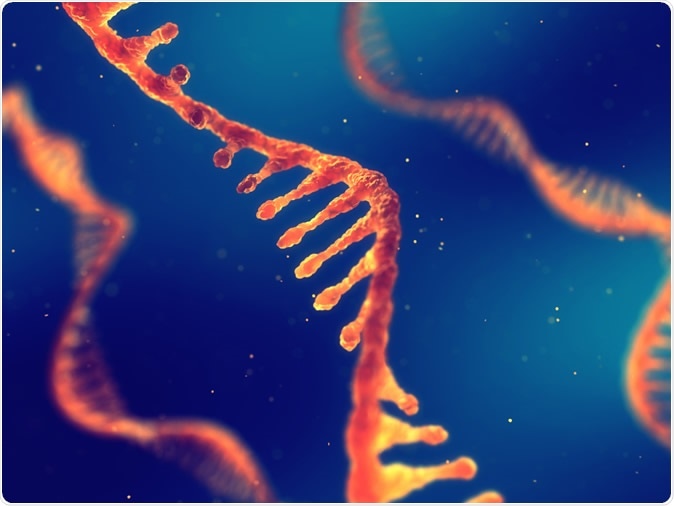Researchers have identified a protein that can kill viruses and it forms the missing clue to the natural antiviral mechanism of the body that can target the viruses based on their genetic patterns. This newly identified protein is called KHNYN.
The results of the new study from the researchers at the King’s College and University College, London, have been published in the journal eLife. The study is titled, “KHNYN is essential for the zinc-finger antiviral protein to restrict HIV-1 containing clustered CpG dinucleotides.”
The team of researchers explain that antiviral mechanisms of the body are a vital area of study because it can help develop not only vaccines against these viruses but also drugs to treat them as well as anticancer drugs. They discovered that the genetic basis of a virus particle is its RNA. They have earlier found that a protein called ZAP (Zinc finger activated protein) can bind to special place on the RNA nucleotides of the virus and the protein is often sandwiched between a cytosine and a guanosine amino acid (CpG). Inhibition of a viruses by ZAP depends on the number of CpG on its RNA.

Single strand ribonucleic acid, 3d illustration - Credit: nobeastsofierce / Shutterstock
There has been research to show that the HIV1 virus has fewer CpG in its genome. This helps the virus escape the ZAP. The team explained that presence of the number of CpG on the HIV1 viruses determined how fast and effectively the virus would multiply. When the team could successfully insert a few CpGs in its genomic sequence, ZAP could easily finish off the HIV1 viruses, the researchers explained. The next question was how to make the ZAP break down the RNA of the virus all on its own.
First author of this study, Mattia Ficarelli, a PhD student in Chad Swanson's Lab, Department of Infectious Diseases, King's College London, said, “As ZAP can't degrade RNA on its own, we believed that it must recruit other proteins to the viral RNA to destroy it. So, in the current study, we set out to identify new human proteins that are essential for ZAP to target viral RNAs for destruction.”
As a result of their investigation, the team came up with KHNYN protein that interacts with ZAP. They increased the amount of this newly found protein in the cells that had been infected with HIV1 virus with smaller number of CpGs. As a comparison they also took cells infected with HIV1 that was genetically engineered to contain more number of CpGs. Results revealed that when the HIV1 had fewer CpGs, their ability to multiply was more and addition of KHNYN reduced this ability by five times. On the other hand the capability of multiplication of genetically engineered HIV1 with more CpG was reduced by up to 400 times by the addition of KHNYN.
To further their experiment the team then looked at the collaboration between ZAP and KHNYN. They tool cells without ZAP and infected them with HIV1. Addition of the protein KHNYN to these cells failed to kill them effectively despite the fact that the HIV1 viruses in the cells were rich in CpG (a factor that made them more susceptible to ZAP inhibition). On the other hand they took cells infected with HIV and a mouse leukemia virus with many CpGs in them and removed KHNYN from them. Results showed that the ZAP was unable to kill these viruses.
Thus both sets of experiments proved that both ZAP and KHNYN were working in tandem to kill the virus particles and further virus particles with more CpGs were more susceptible to these virus killing mechanisms.
Professor Stuart Neil, Department of Infectious Diseases, King's College London, and correspondent author of the study said, “We have identified that KHNYN is required for ZAP to prevent HIV from multiplying when it is enriched for CpGs.” He explained that this newly found protein KHNYN was mostly likely to be an enzyme that helps to cut up the virus RNA after ZAP is bound to it.
Lead author lecturer Chad Swanson, from the Department of Infectious Diseases, King's College London added, “An interesting potential application of this work is to make new vaccines or treat cancer. Since some cancer cells have low levels of ZAP, it may be possible to develop CpG-enriched, cancer-killing viruses that would not harm healthy cells. But much more research is necessary to learn more about how ZAP and KHNYN recognise and destroy viral RNA before we can move on to explore such applications.”
Journal reference:
Mattia Ficarelli, Harry Wilson, Rui Pedro Galão, Michela Mazzon, Irati Antzin-Anduetza, Mark Marsh, Stuart JD Neil, Chad M Swanson, 'KHNYN is essential for the zinc finger antiviral protein (ZAP) to restrict HIV-1 containing clustered CpG dinucleotides', eLife 2019;8:e46767 DOI: 10.7554/eLife.46767, https://elifesciences.org/articles/46767